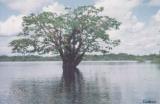Tourism in the Yasuní National Park
Tourism in the Yasuní National Park
Yasuní
National Park
Foto: Selva tropical - Rainforrest - Regenwald
The Yasuni National Park is located in the Pastaza and Orrellana provinces, between the Curaray River and the Napo River.
Yasuni was designated by Unesco in 1989 as a biosphere reserve.
A part of the South of the Yasuni National Park was declared an Intangible Zone, to protect the peoples in voluntary isolation, the Tagaeri, Taromenani, Onamenani, also (Waorani).
CI
Yasuní, the largest protected area in continental Ecuador, preserves an impressive biodiversity in the heart of the Amazonian tropical rainforest and protects part of the territory of the Waorani nationality. In Yasuní, surprising biodiversity figures have been reported for various groups of flora and fauna, never before recorded in any protected area.
Here we find hundreds of species of trees, wide rivers that overflow with torrential rains and large animals such as the jaguar, the anaconda and the harpy eagle.
We also find very small beings, such as the lion or pocket monkey, the smallest primate in the world, and a great variety of reptiles and amphibians that place this park among the most biodiverse in the world.
The human side of the Yasuní is also full of surprises. The Tagaeri and Taromenane, Indigenous Peoples in Voluntary Isolation, live within the park. To protect them and the biodiversity of Yasuní, the Tagaeri-Taromenane Intangible Zone was created in 1999. The Yasuní National Park, the Intangible Zone and the adjacent Waorani territory were declared a Biosphere Reserve by UNESCO in 1989.

Other Natural o Protected Areas and Spots
Galapagos - Llanganates - Ilinizas - Chimborazo - Sangay - Yasuni - Cuyabeno - Machalilla - Cotopaxi
Lagunas Cuyabeno Provincia Sucumbios Areas Protegidas
From Quito
By air or land you must reach the city of Puerto Francisco de Orellana (Coca). From here, depending on the destination, there are several routes, mainly river.
Fuente: areasprotegidas.ambiente.gob.ec
Francisco de Orellana or also called Coca is the capital of the Orellana province. The city of Francisco de Orellana has 18,000 inhabitants.
Biodiversity
Yasuní is one of the most biodiverse areas of the Earth studies speak of 150 amphibian species, 121 reptiles, 598 bird species, between 169 (confirmed) and 204 (estimated) mammals, and flora have been identified 2113 species and it is estimated that there are around 3100





